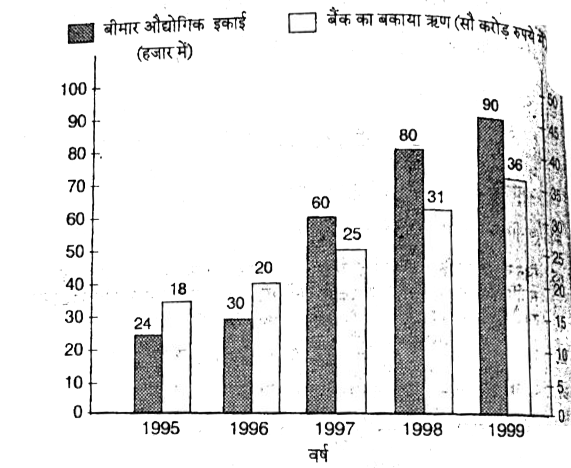(mbmc)b+c−a×(mcma)c+a−b×(mamb)a+b−c का मान है
0
1ma+b+c
1
mabc
The correct Answer is:C
Step by step video, text & image solution for (m^b/m^c)^(b+c-a) xx (m^c/m^a)^(c+a-b) xx (m^a/m^b)^(a+b-c) का मान है by Maths experts to help you in doubts & scoring excellent marks in Class 14 exams.
Updated on:21/07/2023Topper's Solved these Questions
- घातांक एंव करणीBook:MAHESH MISHRAChapter:घातांक एंव करणीExercise:4 B (प्रतियोगी परीक्षाओं में पूछे गए प्रश्न)
Explore 89 Videos
- ग्राफBook:MAHESH MISHRAChapter:ग्राफExercise:29 C प्रतियोगी परीक्षाओं हेतु अभ्यास प्रश्नमाला
Explore 71 Videos
- चक्रवृद्धि ब्याज Book:MAHESH MISHRAChapter:चक्रवृद्धि ब्याज Exercise:10C प्रतियोगी परीक्षाओ हेतु अभ्यास प्रश्नमाला
Explore 62 Videos
Similar Questions
(36)1/6 = ?
View Solutionविभिन्न वर्षों में बीमार औद्योगिक इकाईयों की संख्या (×1000) तथा बैंक का बकाया ऋण (×100) करोड़ रुपये में

किस वर्ष बैंक का ऋण प्रति बीमार इकाई अधिकतम था ?
View SolutionRs. 4500 की राशि 10% वार्षिक चक्रवृद्धि ब्याज दर से 2 वर्षों में कितने रूपये हो जाएगा ?
View SolutionIn a ABC,A=2π3,b−c=3√3cm and area (ABC)=9√32cm2. then 'a' is 6cm b. 9cm c.18cm d. none of these
View SolutionIn a ABC , AD is the bisector of ∠A , meeting side BC at D . If BD=2.5cm, AB=5cm and AC=4.2cm , find DC . (ii) If BD=2cm, AB=5cm and DC=3cm, find AC . (iii) If AB=3.5cm , AC=4.2cm and DC=2.8cm , find BD .
View SolutionIn a ABC , AD is the bisector of ∠A , meeting side BC at D . If AB=10cm , AC=14cm and BC=6cm , find BD and DC (ii) If AC=4.2cm , DC=6cm and BC=10cm , find AB . (iii) If AB=5.6cm , AC=6cm and DC=3cm , find BC .
View SolutionIn Fig. 4.60, check whether AD is the bisector of ∠A of ABC in each of the following: (FIGURE) AB=5cm, AC=10cm, BD=1.5cm and CD=3.5cm (ii) AB=4cm, AC=6cm, BD=1.6cm and CD=2.4cm (iii) AB=8cm, AC=24cm, BD=6cm and BC=24cm
View SolutionIn which of the following cases can a right triangle ABC be constructed? AB=5 cm, BC=7 cm, AC=10 cm AB=7 cm, BC=8 cm, AC=12 cm AB=8 cm, BC=17 cm, AC=15 cm None of these
View SolutionIn a 100 m race, A beats B by 10 m and C by 13 m. In a race of 180 m, B will beat C by (a) 5.4 m (b) 4.5 m (c) 5 m (d) 6 m
View SolutionIf M=a+bc, then b=______
View SolutionIf M=a+bc, then b=______
View SolutionIf a,b,c,l and m are vectors, prove that
[a b c] (l×m)=∣∣ ∣∣abca⋅lb⋅lc⋅la⋅mb⋅mc⋅m∣∣ ∣∣
View SolutionIn a △ABC , AD is the bisector of ∠A , meeting side BC at D . (i)IfBD=2.5cm, AB=5cm and AC=4.2cm , find DC . (ii)IfBD=2cm, AB=5cm and DC=3cm, find AC . (iii)IfAB=3.5cm , AC=4.2cm and DC=2.8cm , find BD .
View SolutionIn ABC , the bisector of ∠A intersects BC in D . If AB=18cm , AC=15cm and BC=22cm , find BD
View SolutionABC is an isosceles triangle in which ∠C=90o . If AC=6cm , then AB= 6√2cm (b) 6cm (c) 2√6cm (d) 4√2cm
View SolutionIn which of the following cases can a right triangle ABC be constructed?
(a) AB=5 cm, BC=7 cm, AC=10 cm
(b) AB=7 cm, BC=8 cm, AC=12 cm
(c) AB=8 cm, BC=17 cm, AC=15 cm
(d) None of these
View Solution